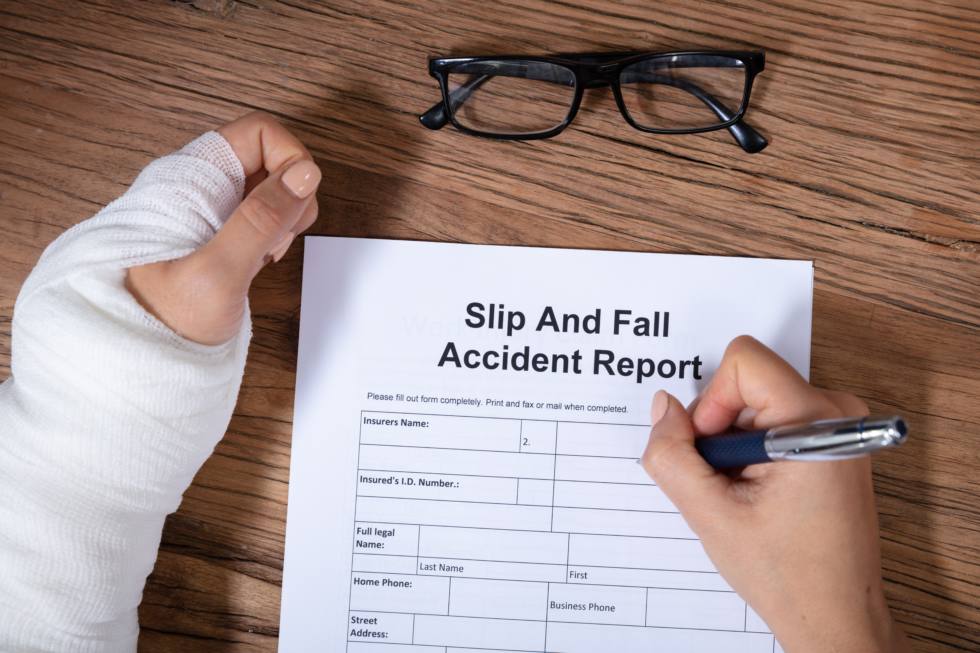Slip & Fall vs. Trip & Fall
When making a report after a workplace accident, it’s always important to be as specific as possible, detailing where, when and under what circumstances the incident occurred. Unsurprisingly, then, it’s also important to use precise language when describing the cause and the nature of the injury. And when it comes to trips, slips and falls, that can sometimes be tricky to do.
According to the Occupational Safety and Health Administration (OSHA), there are three factors involved in slips, trips and falls: friction, momentum and gravity.
- With slips, there’s just not enough friction between your feet and the surface you’re walking on. As you lose traction, you also lose your balance and fall.
- Trips happen when your foot hits something—an object or a change in elevation—and the disruption to your momentum throws you off balance.
- Falls occur when you move too far off your center of gravity.
It’s simple enough to understand how a fall, especially one from a great height, is a distinctive, often quite serious, accident, but how different are slips and trips, and how different are the resulting injuries?
Slip and fall accidents: how and why they occur
Slip and fall accidents typically happen when you lose traction on a slippery surface. Cleaning solutions or water from mopping, spills of any type, floor wax or even low-friction carpets can make for unexpectedly slippery floors. Outside, ice or loose landscaping material poses a risk.
When you lose traction while walking, you fall backward, making slip and fall injuries sometimes quite serious. They include:
- Head injuries
- Back injuries
- Broken or bruised tailbones
- Broken hips
- Sprained ankles
- Sprained or broken wrists
- Dislocated shoulders
To avoid slips, safe workplaces should always place warning signs after cleaning. Spills should be reported and cleaned promptly. Waxes should be formulated to minimize skids. And for worksites that are regularly wet, it may be necessary to install a false floor or raised mats or to issue waterproof and nonslip footwear.
Trip and fall accidents: how and why they occur
Trip and fall accidents occur when you run into something while walking and lose your balance. Tools that are improperly stored, boxes left in a hallway, electrical cords, unmarked stairs or broken and uneven pavement are all common trip hazards. Low light can increase the risk.
When your momentum is disrupted and you’re unable to correct it, the resulting fall forward may lead to:
- Broken arms or fingers
- Sprained wrists
- Injured knees
- Cuts and scrapes
- Injuries to the face
To minimize trips, workplaces should keep public areas clear of clutter and excess furniture or other objects. Electrical cords shouldn’t cross walkways. Carpets that are bunching or bulging, as well as carpet squares that are out of alignment, should be professionally adjusted or replaced. Good lighting will also make it easier to notice and avoid any objects.
What you should do after a slip and fall or a trip and fall
Slips and trips are hazards for workers across industries, including healthcare employees, food service workers and poultry processors. After an accident, report it to your manager or supervisor and try to document the scene, taking special note of:
- Any objects that were not in their correct locations
- A lack of warning signs
- Lighting conditions
- What you were wearing
Talk to coworkers or other witnesses about what they saw. The way you describe your accident is important. As soon as you’ve received the medical attention you need, write down what happened and what injuries occurred.
Your Georgia Workers’ Compensation Lawyer
If you’ve been injured on the job, a Georgia workers’ compensation lawyer can help. At the Law Offices of Laura Lanzisera, we’ll work to explain Georgia’s workers’ compensation system and the benefits available for your injury or disability. Contact the Law Offices of Laura Lanzisera today for a free consultation, or give us a call at 404-991-5097.

Leave a Reply
Want to join the discussion?Feel free to contribute!